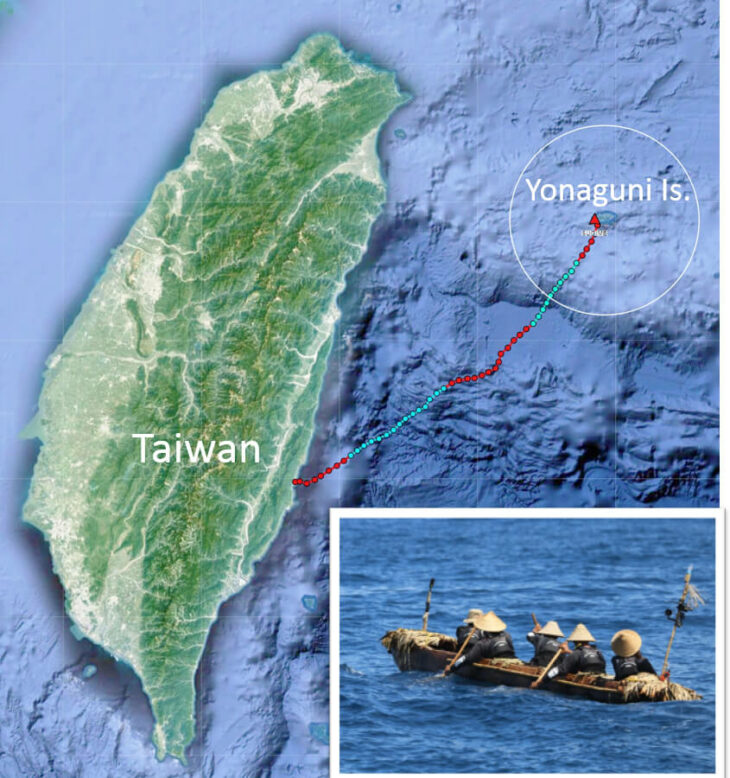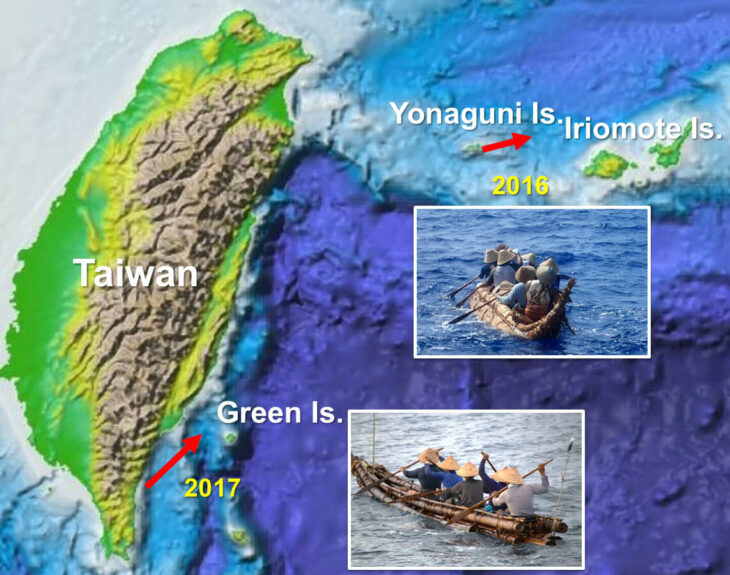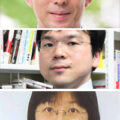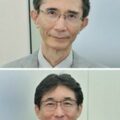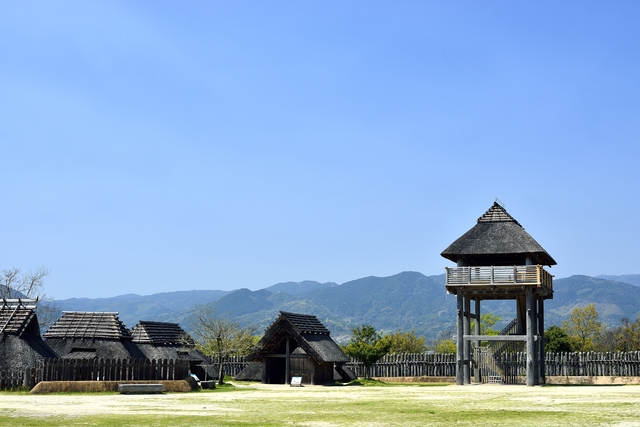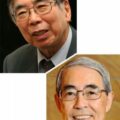What We Understood through the “Holistic Reenactment Project of the Voyage 30,000 Years Ago” (2016–2019) —A New Frontier of Anthropology and Science from Japan—
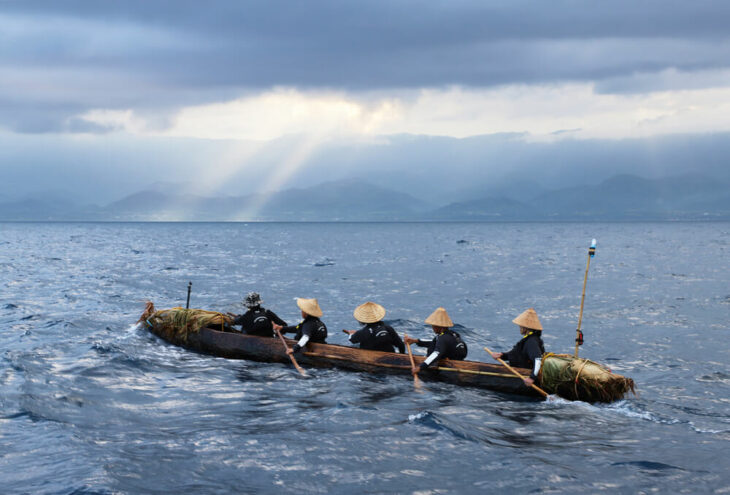
200-kilometer voyage from Taiwan to Japan in 2019
Photo: Courtesy of National Museum of Nature and Science, Tokyo
The diverse staff that made possible the “reenactment”
Kawabata Hiroto The logboat (dug-out canoe) carrying five persons that set out from eastern Taiwan on July 7, 2019 reached Yonaguni Island in Okinawa after 45 hours. I’m so happy everyone in the crew made it there safely.
Kaifu Yousuke Thank you.
Kawabata I have previously written Wareware wa naze wareware-dake nanoka―Ajia kara kieta tayona ‘Jinrui’ tachi (Lost in Evolution: Exploring Humanity’s Path in Asia) under Dr. Kaifu’s supervision, and am well aware of the general outline of the Holistic Reenactment Project of the Voyage 30,000 Years Ago since I’ve supported the crowdfunding, but could you please explain it briefly to our readers?
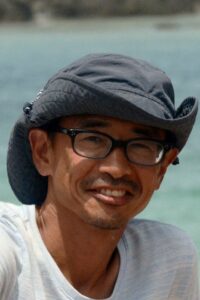
Kaifu Yousuke
Kaifu Certainly. First of all, we believe that Homo sapiens, who emerged in Africa, came to the Japanese islands via three routes. That’s the route from Sakhalin to Hokkaido, the route from the Korean peninsula via Tsushima Island, and the route from Taiwan to the Ryukyu Islands of Okinawa.
Hokkaido and the Eurasian continent were joined by land during the glacial age, while the Korean peninsula and Tsushima Island are visible from each other. By contrast, the route from Taiwan to Okinawa is considered the most severe route as the islands are small, it’s tens or even 200 km between islands, and you can’t see the island you’re headed for. This project was something we started to clarify how such a voyage was possible. Although we call it a “holistic reenactment,” the sea is of course different from what it was 30,000 years ago and there are so many things we don’t know, so it’s impossible to do an accurate reenactment. Nonetheless, we did everything we could to reenact it as much as possible.
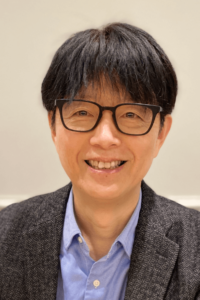
Kawabata Hiroto
Kawabata There was a whole range of staff involved, right?
Kaifu We made sure to run the project through a lively exchange of views from research professionals, boat-building professionals, and rowing professionals.
For example, we had help from an oceanographer studying sea currents, giving us advice and estimating the currents 30,000 years ago with a super computer, and we asked a mathematical biologist to simulate how many persons you would need to have population growth at the immigration destination. We also consulted a botanist about what materials to use to build the boat, and so on.
Also, you can’t have novices rowing the boat. We asked for the help of sea kayaking professionals or semi-professionals. Moreover, they chartered their course by themselves with clues from the topography, the stars, the moon and the sun, without using any clocks, maps or compasses. We also asked experts to do the boat-building.
During the actual voyage, the rule was for the rowers to search for Yonaguni Island using their own eyes and senses, so the accompanying boats monitored their safety, but did not provide any other information.
Kawabata I followed the voyage on the GPS data website, which was also made available to crowdfunding supporters. That was a lot of fun. It was so exciting to be able to follow the boat’s actual location in real-time, I couldn’t sleep.
Kaifu Among the crowdfunding rewards, there were various extras and an invitation to an event at the National Museum of Nature and Science (hereafter NMNS), but the biggest reward was conveying contents. First, we regularly communicated progress through email newsletters, with a policy of telling our supporters even before the mass media. Toward the end, we wanted them to be able to see it live, so we took the wake data that we had introduced for safety reasons, and made it available to our supporters and the mass media.
Additionally, since some of our research funding was public, we used our funds from crowdfunding mainly toward testing, PR, operating expenses for filming and PR, and to pay private individuals helping us out. It was funds for open science, meaning testing and outreach.
Kawabata What kind of people did the supporters tend to be?
Kaifu Some were old friends, researchers and other acquaintances, but the majority were people we didn’t know. Surprisingly, many were women and children. It was very touching when a little girl sent us her 500-yen.
Kawabata I guess some made investments like that so that they could support the project as parents and children.
Kaifu Right. It’s mainly elderly men who are fans of history, but that really wasn’t the case this time. I really felt that if we adapt the way and the contents we communicate, we can bring excitement to many more people.
The Successful Experiment Deepened the “Mystery” Further
Kawabata I remember what you built first in 2016 were reed-bundle rafts. Back then, the struggling footage was startling… I felt that even if you’d succeed, that would be pretty far down the line.
Kaifu That process was valuable, and we didn’t know what kind of boats reed-bundle rafts were until we tried building them. Reed-bundle rafts don’t sink but they’re slow, and if there’s a current, they get dragged along and can’t go forward. What we built next were bamboo-raft boats, but that didn’t go well either. This led us to narrow it down to logboats. Since logboats are technology from the Jomon period (c. 14,000–800 BCE), it didn’t make sense to suddenly use them for the reenactment of a voyage 30,000 years ago. That’s why it was meaningful to first actually try building the reed-bundle rafts and bamboo-raft boats.
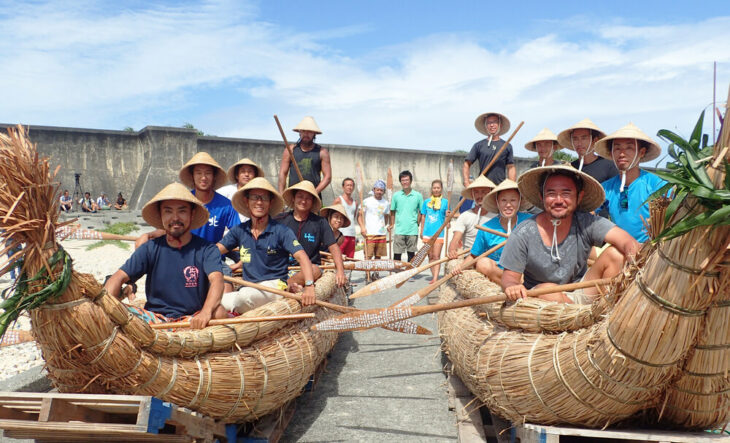 Reed-bundle rafts we made in 2016 with the male and female paddlers. (Photography by Danee Hazama) |
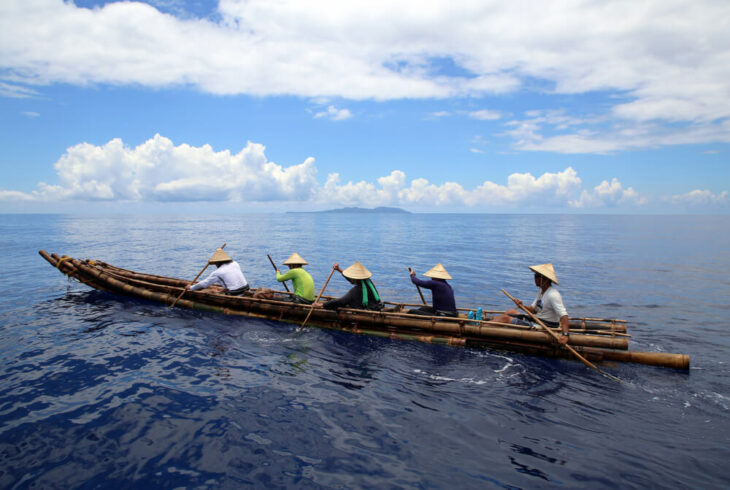 A bamboo raft we made in 2017.(Photograph by Kaifu Yousuke) |
Kawabata Right after they arrived, you commented that “the mystery deepens.” What did you mean?
Kaifu It’s really difficult to try to get to an island you can’t see. The rowers knew the relative position and distance based on modern knowledge. To know the specs of the boat, we measured its speed and used current charts, so could predict that it might work if we do it this way. One aspect of how we succeeded is that we made a plan based on information like that.
Thirty thousands years ago, they set out for an island they couldn’t see without any such information. There’s a limit to primitive technology, and success demanded all human capabilities, also including discernment about currents, weather and other conditions. We’re now even less sure how they did it.
There are those who think that many boats set out, many people died, and a few reached their destination; but would anyone get on a boat they don’t know where it’s going and with a big risk of failure? People who use boats know their limitations. It’s reasonable to think they were at least somewhat confident if they set out. If they weren’t, they wouldn’t have gone.
There are times when you can’t find the answer even if you think about it, but it’s important to think. I think one good thing about having done this project is that it made people think about this and other things.
What Was Humanity Really Like 30,000 Years Ago?
Kawabata In regular science, you might come up with a hypothesis to test at every little step. But I think this project made us realize that there are some mysteries you don’t even know unless you try it out as part of the holistic reenactment of a grand story. I think this is something that makes this project stand out.
Kaifu In this project, we did things that nobody has done before, which had the result of considerably broadening our understanding, but there were many things that never reached the stage of evidence. First, we used logboats. We can’t deny the possibility that they didn’t, but looking at our results, it seems unlikely that you could cross over without a logboat. It can’t be denied that the discussion has made progress two or three steps forward. I want to know the answer to the question “Why are there people on the Japanese islands and how did they get here?” but there are no boats left and the remains don’t provide an answer. That’s why we made a scenario like “Perhaps it was like this” and tried it out. There’s a lot of possible problems, like what will we do if the scenario is wrong or what do we think about how different the sea is today compared to 30,000 years ago. Even so, if we stop there, then we’ll never know what it means to cross the sea.
If we just look at stone tools from 30,000 years ago, most people will probably think “How primitive. What idyllic lives they must have led.” Yet they crossed the sea with those primitive tools. In reality, they too were doing something new. With that in mind, we get a completely new image of what humanity was like 30,000 years ago. The trial voyage has given us a glimpse of what they really were like, which we hadn’t had until now.
I used to feel envious about the Cro-Magnons in Europe. Cro-Magnon man painted in caves, leaving behind fantastic works of art. I used to wonder what our ancestors were doing since they were the same Homo sapiens but almost nothing like that had been discovered in Asia. And what I really got into then was “crossing the sea.” It was because Cro-Magnon man never traveled the sea.
More recently, paintings have been found in Asia too. In the end, neither was better than the other. Asia was doing their own original and advanced things in a different way. That was something I wanted to study in depth. And the background for this project was that since the remains don’t provide any answers, we should try doing it ourselves.
A School Yard That Records 35,000 Years of History
Kawabata I know that you contacted a number of experts to renew the permanent exhibitions at the NMNS. I think that had a lot to do with your activities now, but is it so?
Kaifu That really was the starting point. When I was thinking about doing a big reorganization of the permanent exhibitions fifteen years ago, that opened up a world of exhibitions on the theme of Homo sapiens’ spread across the world.
Traditional exhibitions are focused on Neanderthal man, Cro-Magnon man and Europe, and have little to do with Japan. But you can’t see the whole world from just Europe. Having said that, it’s weird to just display Europe and Japan, so we made a world map on the floor and showed what Homo sapiens did and where they went all over the world.
Of course, since I couldn’t do it all by myself, I approached some very knowledgeable professors and asked, “I’m renewing these exhibitions, so please teach me,” and they all helped me out. That taught me quite a lot.
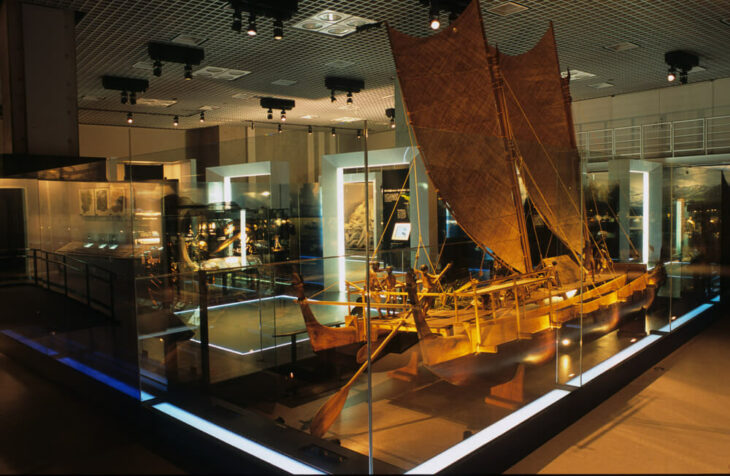
A scene from the permanent exhibitions of National Museum of Nature and Science, Tokyo
Photo: Courtesy of National Museum of Nature and Science, Tokyo
Kawabata One thing that’s interesting about the NMNS exhibitions, for example, is that you’re displaying the school yard of Takaido Elementary School in Suginami City, Tokyo but have unearthed the ground as it was 35,000 years ago, revealing stone tools and other things from the Paleolithic. When you think about the children running around on top of this rich accumulation of history, it’s astounding.
The history of Homo sapiens has so much that will make you gaze in wonderment. The Japanese islands where we live stand on that same accumulation of history. I think what makes the current permanent exhibitions at the NMNS so great is that it’s well-thought-out, making you feel that the human history that started in Africa is connected with the yard of a local elementary school.
Another thing that impressed me with the NMNS is the description of the obsidians that researchers found in soil layers from 30,000 years ago all across Honshu. Analysis showed that they had been produced on Kozu-shima Island of the Izu Islands. It’s amazing that these obsidians that wouldn’t be there unless transported by boat are popping up in so many locations. Recently, you’ve also included the news that the world’s oldest fishing hook was found in Okinawa. It shows that there’s actually quite a lot of good stuff in Japan.
The so-called Great Journey that describes how humanity moved from Africa to Eurasia, Siberia and southernmost South America makes Asia into no more than a waypoint, but the exhibition shows how Japan is part of that story too. The rich stories of our ancestors are beneath our feet as well. I hope the people visiting the NMNS get to see that.
Kaifu The vast majority think that Paleolithic man lived in a mountain somewhere, but they lived on the plains. I think that fact alone is very interesting.
Kawabata I wish elementary- and middle-school textbooks today would go all the way back to and talk about that time. Around year 3 of elementary school, the children are supposed to learn about history on the municipal level, like “Our Suginami City,” and around year 4, they’re supposed to learn about it on the prefectural level, so it would be good if they could see what amazing history their area has.
Kaifu The role of museums is not just to display actual samples, but it’s also to store and manage those samples for research. The museums have collections that are not open to the public, where researchers conduct basic research.
Kawabata The NMNS storage in Tsukuba City has an endless collection of something like human bones from the Edo period. There are mole researchers who do nothing but collect mole specimens. Those might be used by people a century later, since we actually have people doing research with objects from a century ago.
Kaifu As technology becomes more advanced, you can do analyses that were not possible in the past. We collect a lot of human bones, and as an example, we found out what Jomon people ate by analyzing the composition of their bones. DNA research is also becoming more advanced.
If we have old shellfish, we can interpret from them what the climate was like before weather observations started. We can gain more information by the things we keep. That’s also the museums’ role. Some politicians who don’t get this will say that the samples can be discarded once you’ve written a paper on them, but I want people to know that one purpose of museums is to be banks of valuable data.
Kawabata I think some people in the general public think of you as an archeologist, so they might be surprised to hear you talk about DNA. Archeology and anthropology are in fact connected, so it’s only natural that they are mixed up, but the two are actually separate as academic genres: archeology in the humanities and anthropology in the sciences. But I hear that the two started interacting quite a bit around the time of your generation.
Kaifu My original specialization was fossil morphology, and I studied the Indonesian primitive hominins for twenty years or so. I was also interested in cultural anthropology but since I grew up in an educational system that separates the humanities from the sciences, I couldn’t study it enough. Nonetheless, I was interested in the history of humanity and wanted to do research about evolution.
We used to talk about human evolution only in terms of Africa and Europe, but I always wanted to know about our evolution in my home of Asia. At the time, we knew almost nothing about Asia, except for the Peking man and the Java man. Few people even cared if there was anyone on the Japanese islands at the same time as the Cro-Magnon man.
I study primitive man because I want to understand humans today. I thought that if we understand what existed before humans better, then we should be able to understand Homo sapiens better. Since I’m doing research to find out more about people, then it doesn’t really matter if I’m using archeology or anthropology.
Writing a Comprehensive History of Homo sapiens
Kawabata Sapiens: A Brief History of Humankind became a bestseller, but how do you view the recent human-history boom?
Kaifu In one sense, it’s a completely natural development. We have a framework that says that the theory of Homo sapiens’ genesis in Africa is essentially true, so if we integrate the data we can glean from there, then we have a movement to write a comprehensive history of Homo sapiens.
What’s fun about Sapiens: A Brief History of Humankind is that the historian Professor Yuval Noah Harari is combining everything from biology to the theory of evolution. That fun element is mixed with animated descriptions of time periods, which makes you realize that he is consistently describing what human beings are through his writing.
This is true for any field, but experts usually cannot go that far. Professor Harari’s book has some mistakes too, but I think there’s something so fun with it that it goes beyond that.
Kawabata Last year, I visited Israel where Professor Harari is. What’s interesting about Israel is that you have direct links all the way back in history to several 10,000 years ago when the Neanderthal man lived, the world of Homo sapiens who had just emerged from Africa, the mythological world of prophets depicted in the Old Testament, and the later world of properly preserved historical documents.
Seen from a place like that, I can understand why you might perceive a connection between several 10,000 years ago and today.
By contrast, Japan is missing a lot of pieces both here and there when it comes to historical continuity, but I think this holistic reenactment project is all about finding pieces like that. That’s why I keep saying that I would like you to write about the “history of humankind” from a Japanese perspective, and I’m confident that it will become a reality.
Kaifu Quite apart from the question of me writing it, in Japan I feel that we often just present what’s been written in Europe and North America. I think we Japanese ought to consider things a bit more from an Asian perspective. It’s not just Japan. China and South Korea also should have broader Asian perspectives.
Kawabata Homo luzonesis that was discovered in Luzon, the Philippines was the fifth new species of primitive hominin found in Asia, and the mysterious Denisova hominin that was recently found in the Tibetan mountains are amazing from a human-history viewpoint, and I think they provide clues to understanding humanity in Asia. What do you think?
Kaifu Until recently, with the exceptions of the Java Man and the Peking Man, Asia was more or less a blank. In recent years, we have made unexpected discoveries in those blank regions, one after the other. Researchers recently found out that a small human of about 1 meter in height named Homo floresiensis used to live in Indonesia until 50,000 years ago.
Yet what’s slightly disappointing is that many of these new discoveries were made by European and North American researchers. I welcome their participation, but they will lack a complete understanding of Asia. History needs to be checked by the people directly concerned and that’s the task of us Asian researchers. We need to get more involved ourselves.
Asia is rapidly becoming more interesting and is garnering attention from all over the world. On the whole, this is a development that we should welcome, so we have to think about what we as researchers ought to do next.
More than research, I think knowing more about humans is something that benefits the world. For example, people traveling to Taiwan will likely focus on cities like Taipei and have few opportunities to know about the aboriginals. Their lives are far from abundant, but at the same time, they are not unhappy. I sometimes envy them. For example, they have songs that they can all sing together during festivals. They have dances they can dance together.
I think that knowing that kind of reality, both the good and the bad, is the start of a real relationship. Today, politics and economy stand at the center of international relations, but anthropology is a field where you can interact in a different way. I hope to contribute to society in such a field.
Japanese Researchers Lack Ideas
Kawabata You have been expanding your sphere of research without distinguishing between archeology and anthropology. You have also broadened your research with ideas like this project that are not really imaginable by normal researchers, and have been actively using approaches like crowdfunding. From your perspective, what challenges will Japanese academia face from here on?
Kaifu There is a lack of funding, but another big issue I see is that Japanese researchers often lack ideas. That’s why there are so few advanced inventions. If you go to a conference, there are few interesting presentations by young people. I fear it might be the same in the industrial world.
Kawabata Do you mean they only do solid stuff that can be made into journal articles?
Kaifu I suppose so. Also, they only do what they’ve been taught. Students are nitpicking the existing fields. By contrast, European and North American research is progressing because they keep coming up with new methods. New methods yield innovations. That’s what young people should be doing. At times, it might happen that some research institute organizes it, but you rarely hear about Japanese graduate students inventing something. I think this is Japan’s weak point. The cause is not just money.
For example, the Japanese researcher who discovered the fluorescent substance in Aequorea victoria was eminent, but I was astonished by the novel idea of the American researcher who used it to create a technology for visualizing microscopic organic phenomena. Such ideas of surprising application is difficult to come by in Japan.
I want young researchers to cultivate an eye for what’s interesting. If a researcher lacks the antenna to find what they themselves think is interesting, then they won’t be able to communicate it.
Kawabata Recently, I’ve been thinking that choice and focus are actually detrimental especially to basic research. When you have chosen and focused on something you think is promising, then that’s not really basic research anymore. I don’t think anyone considered research on Aequorea victoria promising. Does that mean that we no longer have an environment that can support attempts like that?
Kaifu We need academic freedom, but we also need to have a stable structure for what people should do next once they have been given that freedom. At the same time, if we take a look at China, for example, then you will see incredible meritocracy as they continuously send young people to study at European and North American research institutions. They are pressured to write papers and those with a good track record keep getting promoted. I oppose any extreme meritocracy, but I also think Japanese academia needs to change something. If things go on like this, we can’t complain if Japan loses out. Looking at the situation now, I don’t think there’s any bright future for just saying, “Let the researchers be free.”
Translated from“Tokushu:Gakeppuchi no Kagaku-rikkoku / ‘3 man-nen mae no kokai, Tettei saigen purojekuto’ kara mietamono—Taidan: Nippon hatsu no Jinruigaku, sosite kagaku wo tsukuridaso (Feature: Science-oriented country is on the edge / What We Understood through the Holistic Reenactment Project of the Voyage 30,000 Years Ago (2016–2019)—Conversation: A New Frontier of Anthropology and Science from Japan)[March 2020]
Notes
Holistic Reenactment Project of the Voyage 30,000 Years Ago (2016–2019): https://www.kahaku.go.jp/research/activities/special/koukai/en/
National Museum of Nature and Science: https://www.kahaku.go.jp/english/
Keywords
- Kawabata Hiroto
- Wareware wa naze wareware-dake nanoka
- Kaifu Yousuke
- human evolution
- Homo sapiens
- hominids
- National Museum of Nature and Science
- anthropology
- logboat
- Holistic Reenactment Project
- 30,000 years
- Great Journey
- Paleolithic man
- purpose of museums
- Sapiens: A Brief History of Humankind
